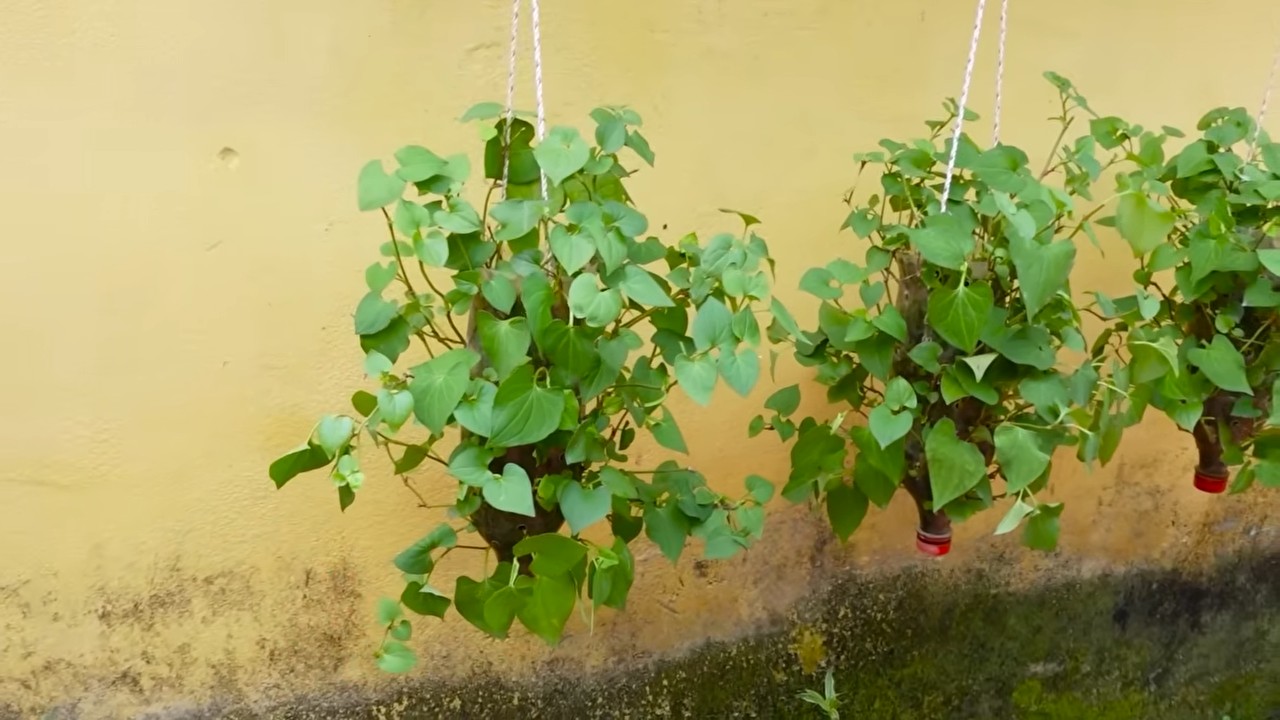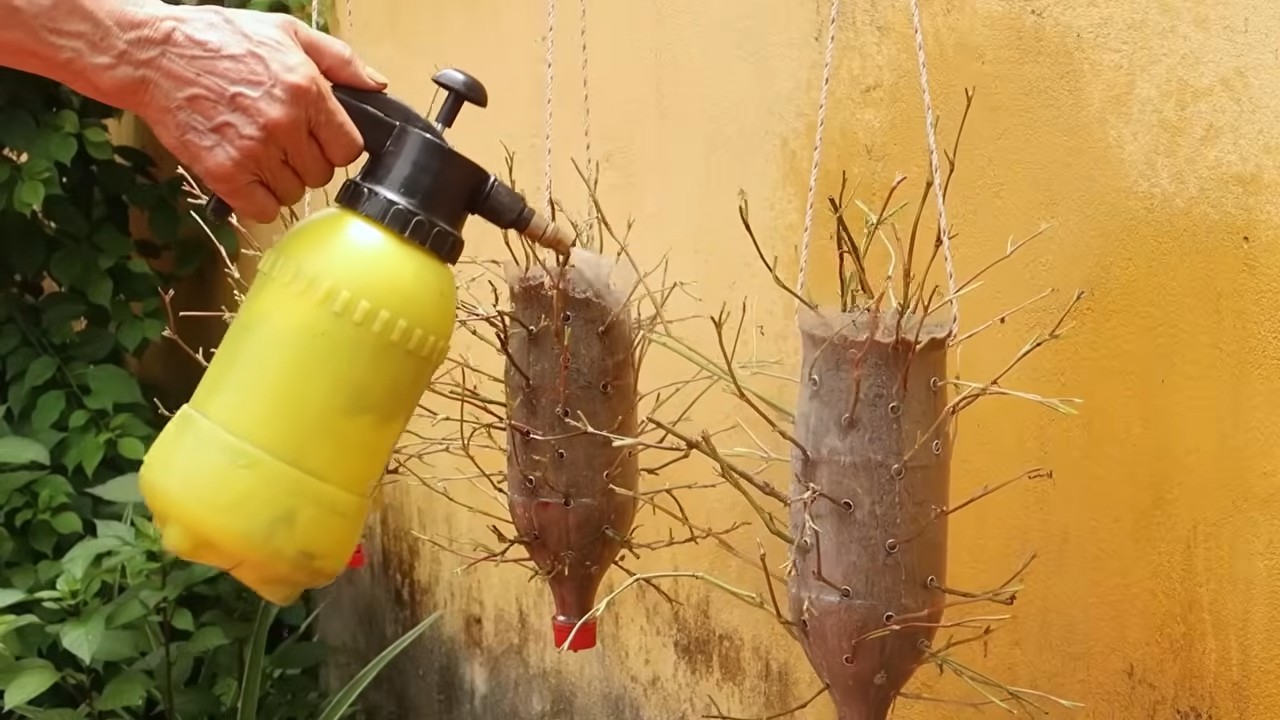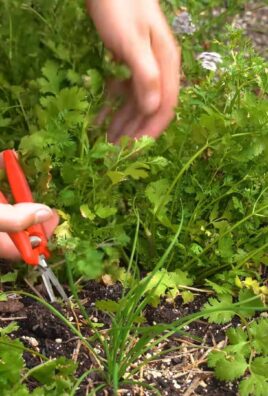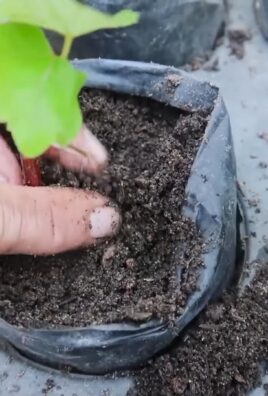Harvesting Fish Mint, also known as Houttuynia cordata, might sound like a peculiar task, but trust me, it’s a culinary adventure waiting to happen! Have you ever stumbled upon a plant with a uniquely pungent aroma, a scent that’s both earthy and, well, a little fishy? That’s likely Fish Mint, a vibrant herb deeply rooted in Asian cuisine and traditional medicine. For centuries, cultures across Southeast Asia, particularly in Vietnam, China, and Korea, have cherished this unassuming plant for its distinctive flavor and purported health benefits.
But why should you care about harvesting Fish Mint? Well, imagine adding a zesty, refreshing kick to your salads, spring rolls, or even your favorite stir-fries. This isn’t just about adding another herb to your garden; it’s about unlocking a whole new world of flavor. Plus, with rising grocery prices, growing your own herbs is a fantastic way to save money and enjoy fresh, organic ingredients. In this DIY guide, I’ll walk you through everything you need to know about successfully harvesting Fish Mint, from identifying the plant to ensuring a bountiful and sustainable harvest. Let’s get started and bring a touch of Asian-inspired freshness to your kitchen!

Harvesting and Using Fish Mint: A DIY Guide for the Garden and Kitchen
Hello gardening friends and home cooks! Today, I’m going to show you how to properly harvest fish mint (Houttuynia cordata), also known as lizard tail, and how to use it in the kitchen in a variety of ways. This plant is not only an eye-catcher in the garden but also a fantastic ingredient for Asian dishes. Let’s get started!
What You Should Know About Fish Mint
Before we start harvesting, here are some important facts about fish mint:
- Fast-growing: Fish mint is known for spreading quickly. It’s best to plant it in a pot or a designated area to prevent it from taking over your entire garden.
- Flavor: The taste is unique – it has hints of fish (hence the name), but also tastes like coriander and lemon. It’s not for everyone, but it’s very popular in Asian cuisine.
- Location: Fish mint prefers moist, shady to partially shaded spots.
- Harvest time: The leaves can be harvested throughout the growing season, but it’s best to do so before the plant flowers.
Materials and Tools Needed
- Garden scissors or a sharp knife
- Basket or container for harvesting
- Gloves (optional, but recommended since the plant can be mildly irritating)
- Water to wash the harvested leaves
The Right Harvesting Technique
Harvesting fish mint is quite simple, but there are a few things to keep in mind to keep the plant healthy and allow it to continue growing.
- When to harvest? It’s best to harvest fish mint in the morning after the dew has evaporated. The leaves are most aromatic at that time.
- How much to harvest? Never harvest more than a third of the plant at once. This allows it enough energy to recover and continue growing.
- Where to cut? Cut the stems just above a leaf node. This encourages the growth of new shoots.
Step-by-Step Harvesting Guide
- Preparation: Put on your gloves (optional) and get your garden scissors and basket ready.
- Selecting the Stems: Choose the healthiest and strongest stems. Make sure the leaves are fresh and green.
- Cutting: Use the garden scissors or knife to cut the stems just above a leaf node. Be careful not to damage the plant.
- Collecting: Place the harvested stems in your basket.
- Repeat: Repeat steps 2-4 until you’ve harvested the desired amount. Remember, don’t harvest more than a third of the plant at once.
- Cleaning: Gently remove any dirt or soil from the leaves.
After Harvest: Washing and Storing
After harvesting, it’s important to properly wash and store the fish mint so that it stays fresh and retains its flavor.
- Washing: Fill a bowl with cold water and place the harvested stems into it. Gently swirl them in the water to remove dirt and soil.
- Drying: Lay the washed stems on a clean kitchen towel or use a salad spinner to dry them thoroughly.
- Storing: There are several ways to store fish mint:
- In the fridge: Wrap the dried stems in a damp kitchen towel and place them in a plastic bag or airtight container. They will last in the fridge for about 3-5 days.
- Freezing: Chop the fish mint finely and freeze it in ice cube trays with water or oil. This way, you always have a portion ready for your dishes.
- Drying: Dry the fish mint in a well-ventilated, shaded spot or use a dehydrator. The dried leaves can be stored in an airtight container.
Using Fish Mint in the Kitchen
Fish mint is a versatile ingredient used in many Asian dishes. Here are a few ideas:
- Spring Rolls: Add a few fish mint leaves to your spring rolls for a fresh, spicy flavor.
- Salads: Use fish mint in salads, especially in Vietnamese or Thai salads.
- Soups: Add fish mint to soups just before serving to give them an extra kick.
- Stir-fry Dishes: Add fish mint at the end of the cooking process to stir-fried dishes.
- Herbal Tea: Pour hot water over fresh or dried fish mint leaves and let them steep. The tea is said to have anti-inflammatory and digestive benefits.
- As Garnish: Use fish mint as a decorative and flavorful garnish for your dishes.
More Tips and Tricks
- Propagation: Fish mint can easily be propagated through cuttings. Simply cut a stem and place it in moist soil.
- Pests: Fish mint is relatively resistant to pests. Occasionally, aphids may appear, which can be easily removed with a water spray or a mild soap solution.
- Overwintering: Fish mint is hardy, but in very cold regions, it may be helpful to cover it with twigs or leaves for extra protection.
- Experimenting: Be bold and experiment with fish mint in your own recipes. Let your creativity run wild!
Final Thoughts
I hope this guide has helped you learn how to harvest and use fish mint properly. With a little practice, you’ll soon become a fish mint expert! Enjoy gardening and cooking!

Conclusion
So, there you have it! Mastering the art of harvesting fish mint isn’t just about gathering leaves; it’s about unlocking a world of culinary possibilities and embracing a deeper connection with your garden. This simple yet effective DIY trick transforms the way you approach this unique herb, ensuring you get the most flavor and the longest-lasting harvest.
Why is this a must-try? Because it’s efficient, sustainable, and ultimately, it elevates your cooking. Instead of haphazardly plucking leaves and potentially damaging the plant, our method encourages healthy growth and maximizes yield. You’ll find yourself with a more robust and productive fish mint plant, ready to provide you with its distinctive flavor whenever you need it.
But the journey doesn’t end here! Feel free to experiment with variations on this technique. For instance, if you live in a particularly hot climate, consider harvesting in the early morning or late evening to minimize stress on the plant. You can also adjust the frequency of harvesting based on your plant’s growth rate and your personal needs. Some gardeners find that harvesting every few weeks works best, while others prefer a more frequent, lighter approach.
Consider using different tools for harvesting. While scissors or pruning shears are generally recommended, you might find that a small, sharp knife works better for you, especially if you’re dealing with a particularly dense patch of fish mint. The key is to find what feels most comfortable and efficient for you.
Beyond the basic harvesting technique, think about how you can incorporate fish mint into your culinary creations. It’s fantastic in salads, spring rolls, and stir-fries, adding a refreshing and slightly pungent note. You can also use it to make a flavorful tea or infuse it into oils and vinegars for a unique twist. Don’t be afraid to get creative and explore the many ways this versatile herb can enhance your dishes.
This DIY trick for harvesting fish mint is more than just a method; it’s an invitation to engage with your garden and your food in a more meaningful way. It’s about understanding the needs of your plants and tailoring your approach to maximize their potential. And it’s about discovering the joy of using fresh, homegrown ingredients to create delicious and memorable meals.
We wholeheartedly encourage you to try this technique and experience the difference for yourself. See how it transforms your fish mint plant and how it elevates your cooking. And most importantly, we want to hear about your experiences! Share your tips, tricks, and culinary creations with us in the comments below. Let’s build a community of fish mint enthusiasts and learn from each other’s successes. Happy harvesting!
Frequently Asked Questions (FAQ)
What is the best time of day to harvest fish mint?
The best time to harvest fish mint is generally in the morning, after the dew has dried but before the sun gets too hot. This helps to minimize stress on the plant and ensures that the leaves retain their moisture and flavor. Harvesting in the cooler part of the day also prevents the leaves from wilting quickly. If you live in a particularly hot climate, harvesting in the late evening might also be a good option.
How often should I harvest fish mint?
The frequency of harvesting depends on several factors, including the plant’s growth rate, the climate, and your personal needs. As a general rule, you can harvest fish mint every few weeks, or even more frequently if the plant is growing vigorously. Avoid harvesting more than one-third of the plant at any one time, as this can weaken it. Regular harvesting encourages new growth and helps to keep the plant healthy and productive.
What tools do I need to harvest fish mint?
The essential tools for harvesting fish mint are a pair of sharp scissors or pruning shears. These tools allow you to make clean cuts without damaging the plant. A small, sharp knife can also be used, especially for harvesting individual leaves. Make sure your tools are clean and sanitized to prevent the spread of disease.
How do I store harvested fish mint?
To store harvested fish mint, gently wash the leaves and pat them dry with a paper towel. You can then store them in a plastic bag or container in the refrigerator. For longer storage, you can freeze the leaves. To freeze, spread the leaves out on a baking sheet and freeze them until solid. Then, transfer them to a freezer bag or container. You can also dry fish mint by hanging the stems upside down in a cool, dry place. Once the leaves are completely dry, store them in an airtight container.
Can I harvest fish mint flowers?
Yes, you can harvest fish mint flowers! The flowers are edible and have a similar flavor to the leaves, although they are often milder. You can use them in salads, as a garnish, or to make tea. Harvest the flowers when they are fully open and in good condition.
What if my fish mint plant is not growing well?
If your fish mint plant is not growing well, there are several things you can check. First, make sure it is getting enough sunlight. Fish mint prefers partial shade but can tolerate full sun in cooler climates. Also, ensure that the soil is well-draining and that the plant is not overwatered. Fish mint prefers moist soil but does not like to sit in standing water. You can also fertilize the plant with a balanced fertilizer to encourage growth. If you suspect that the plant is diseased, consult a gardening expert for advice.
Is fish mint invasive?
Yes, fish mint can be invasive in some areas. It spreads quickly through its roots and can be difficult to control. To prevent it from spreading, consider growing it in a container or in a raised bed. You can also use barriers to contain the roots. Regular harvesting can also help to keep the plant under control.
Can I propagate fish mint from cuttings?
Yes, you can easily propagate fish mint from cuttings. Take a cutting from a healthy stem, about 4-6 inches long. Remove the lower leaves and place the cutting in a glass of water. Roots should start to form within a few weeks. Once the roots are about an inch long, you can plant the cutting in a pot or in the ground.
What are the health benefits of fish mint?
Fish mint is believed to have several health benefits. It is rich in antioxidants and has anti-inflammatory properties. It is also traditionally used to treat respiratory problems, skin conditions, and digestive issues. However, more research is needed to confirm these benefits.
How can I use fish mint in cooking?
Fish mint is a versatile herb that can be used in a variety of dishes. It is commonly used in Southeast Asian cuisine, particularly in Vietnamese and Thai dishes. It can be added to salads, spring rolls, stir-fries, and soups. It can also be used to make tea or infused into oils and vinegars. The leaves have a distinctive, slightly pungent flavor that adds a unique touch to any dish. Experiment with different recipes and find your favorite ways to use this flavorful herb.





Leave a Comment